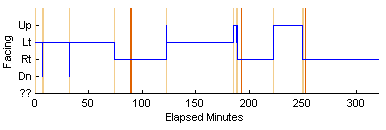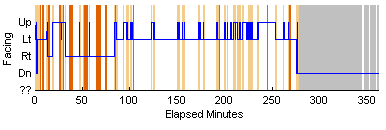

|
Order AcuSleep for your child |

 Gallery of Movements
Gallery of Movements
This page shows movement measurements made by the AcuSleep system.
Introduction
The AcuSleep test measures two types of movements: (a) changes in body position and (b) arm movements. Normally, an arm movement occurs whenever the body position changes. Some arm movements, however, occur without a change in body position. These are called "solo arm movements."The Movement Diagram
The AcuSleep system shows arm movements as vertical lines overlaid on the position diagram. The diagram below is from an AcuSleep study of a normal 5-year-old girl. Each vertical line indicates a solo arm movement.Case 1: A great sleeperIn the figure below, lighter-colored vertical lines have been added at each moment a change occurs in body position. The periods of time between vertical lines are called tranquil periods because the subject is not moving during these times (as far as the AcuSleep system can tell).

This subject is a 48 year old woman who describes herself as a lifelong "great sleeper." Her husband volunteers that the subject is consistently asleep within two minutes after her head hits the pillow. Her AcuSleep test shows a remarkable lack of movement, in terms of position changes and in solo arm movements.Case 2: Severely disturbed sleepThis subject spent 50% of her test time in tranquil periods of at least a half hour. Although a very rapid time-to-sleep is a feature of some sleep disorders, this subject has no symptoms of any sleep disorder. She does indeed seem to be a lucky great sleeper.
This is a hard-charging, very busy, mildly overweight, middle-aged physician that gets little exercise and is "always tired."The subject changed body position 38 times (shown by the lighter vertical lines) and, on top of that, moved his arm 24 more times (darker vertical lines) -- a total of 62 body movements in about 4 hours. The gray area indicates time during which the breathing signal was non-existent. The signal was non-existent because the subject got up for work about 4 hours after going to bed and so removed the AcuSleep recorder. This subject's longest period of tranquil time was 24 minutes. You can listen to some of this unfortunate person's breathing sounds in the sound gallery.

 Nothing herein should be construed as medical advice. Terms and Conditions. Privacy.
Nothing herein should be construed as medical advice. Terms and Conditions. Privacy.
Copyright (C) 2002-2005 by Apneos Corporation. All Rights Reserved. Patents pending.
v.DIA-V

